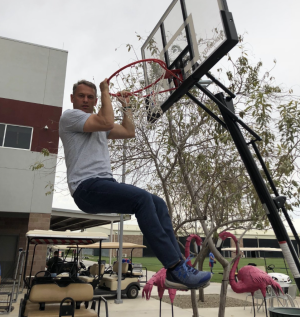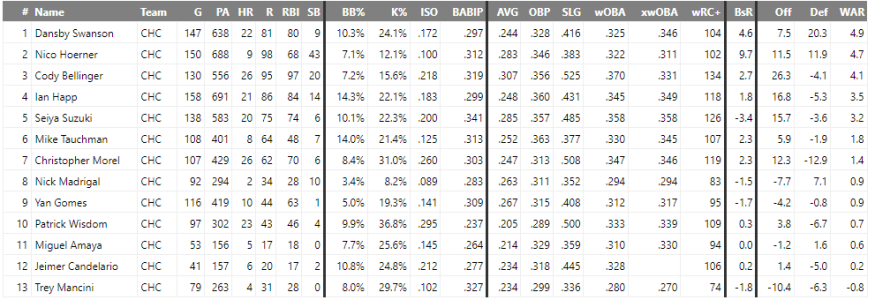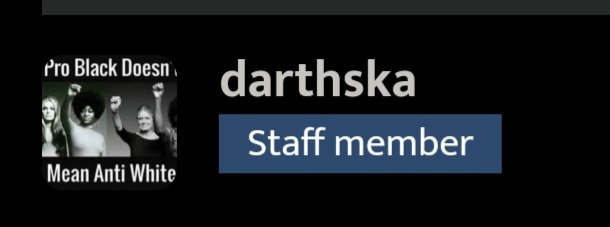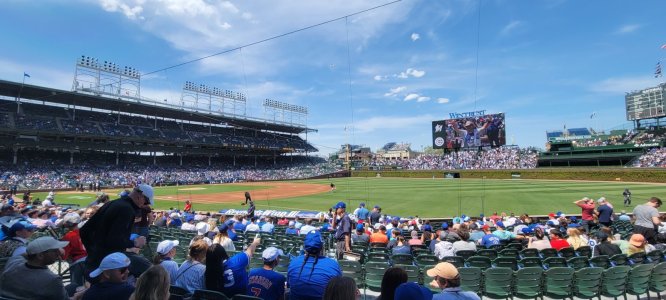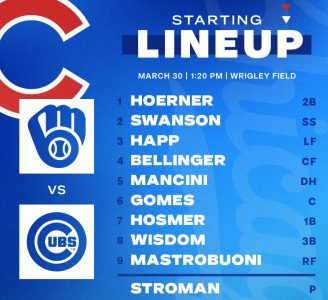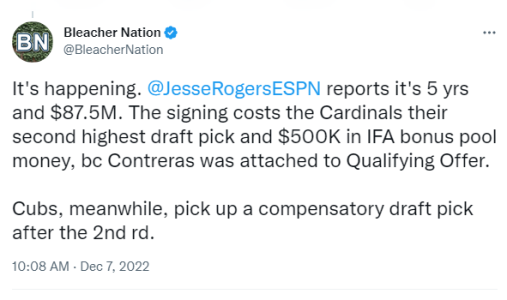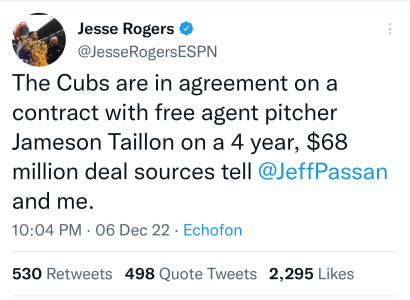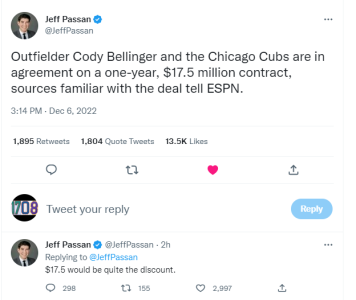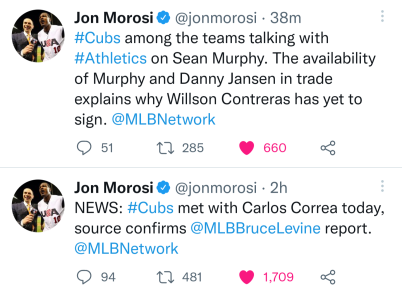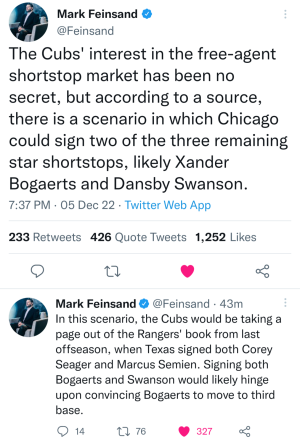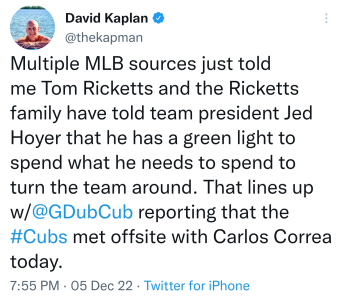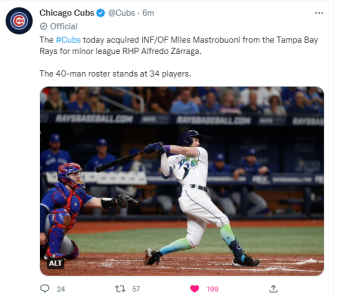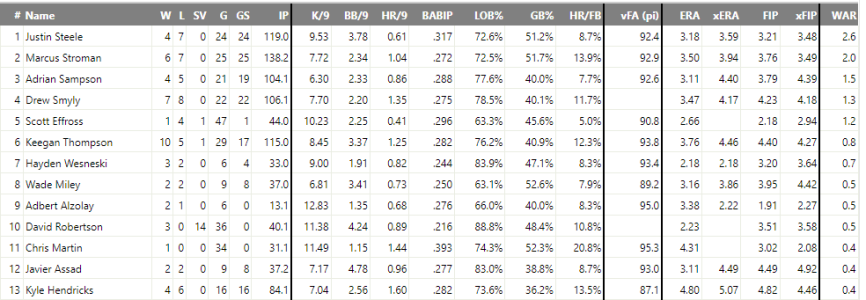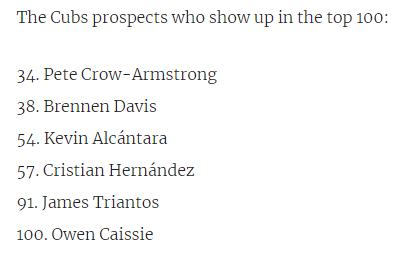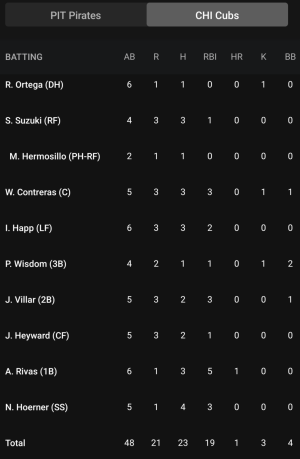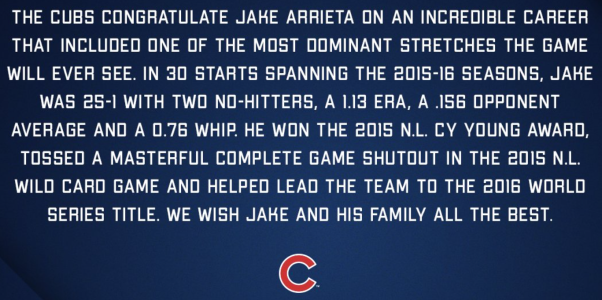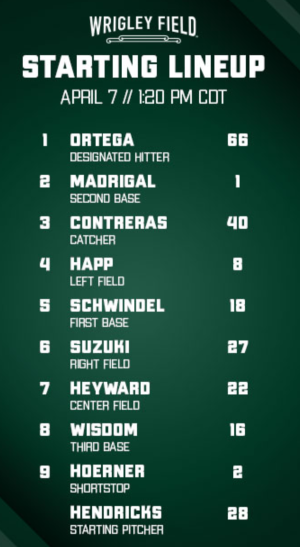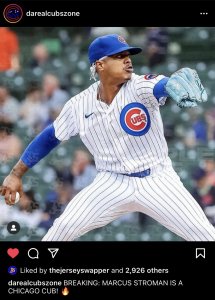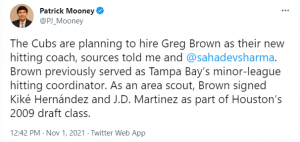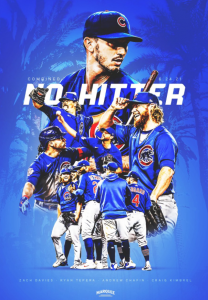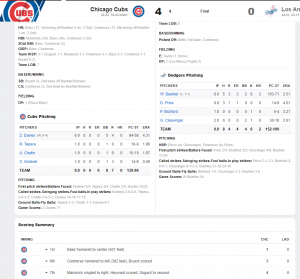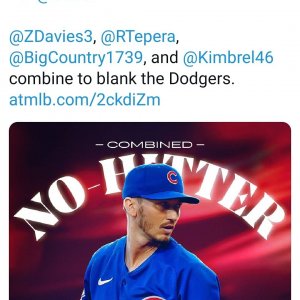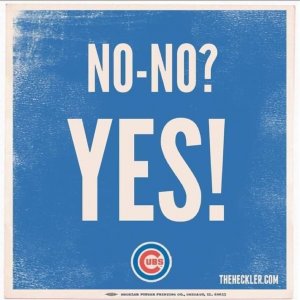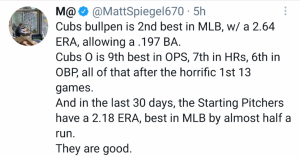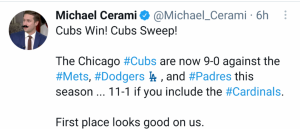This might have been the best chance for the Cubs to win a World Series in your lifetime. Or it could have been the opening scene for a dynasty. The point is you never know.
Yes, this franchise is positioned to get back to October over and over again, but there are zero guarantees. The Cubs stayed exceptionally healthy, developed a special chemistry and shattered all their internal projections for a talented young nucleus.
That’s why this should sting, even with all the unexpected good times at Wrigley Field this summer, the laugh-out-loud quotes from manager Joe Maddon, the quantum leaps made by rookies Kris Bryant, Addison Russell and Kyle Schwarber, the spontaneous clapping to the music when Anthony Rizzo and Starlin Castro walked up to home plate.
But it’s not like the New York Mets are a smoke-and-mirrors team that just swept the National League Championship Series with Wednesday night’s 8-3 victory in Game 4, leading for all 36 innings and showing their foundation should be built to last.
“I don’t want any of the guys to take it for granted,” catcher Miguel Montero said afterward. “You got to remember we maybe made it look a little easy the first year and we got to the NLCS. But don’t take it for granted. And I say that because I lived that before.”
Montero had been part of the 2007 Arizona Diamondbacks team that swept Lou Piniella’s Cubs in the divisional round – and then got swept by the Colorado Rockies – and wound up finishing two games over .500 in 2008.
“We were a young team who got to the NLCS,” Montero said. “A year later, we didn’t do anything. We played good, but not good enough. That’s my advice: Don’t take it for granted.
“Next year, just get to spring training with the same intensity, even hungrier than this year, so we finish what we started.”
The Cubs still haven’t advanced to the World Series since 1945 or won a championship in 107 years, the longest droughts in North American professional sports.
With Jacob deGrom, Matt Harvey, Steven Matz and Noah Syndergaard, the Mets have four frontline starters between the ages of 22 and 27. That group limited the Cubs to six runs across 25 innings, notching 29 strikeouts by mixing speeds, hitting spots and consistently approaching triple-digit velocity.
“With good health, these guys are going to be good for many years to come,” manager Joe Maddon said. “There’s no question.”
Remember, the Cubs finished third in the division behind the St. Louis Cardinals and Pittsburgh Pirates. The Washington Nationals are still stacked with perennial MVP (Bryce Harper) and Cy Young Award (Max Scherzer) candidates. The Los Angeles Dodgers have a seemingly unlimited checkbook to fix a 92-win team. The San Francisco Giants have those three World Series titles since 2010.
It’s going to get more complicated now, bigger egos and bigger expectations surrounding this team. The harsh reality for the 2016 Cubs is that winning 90-plus games will be met with so-what shrugs and not the shaking-your-head, what-just-happened looks of joy and amazement.
That’s why president of baseball operations Theo Epstein understood this would be the end of the innocence, relating it to a conversation with his old buddy, Pearl Jam’s Eddie Vedder.
The 2015 Cubs would be like the band that catches fire with a first record, bursting onto the national scene, enjoying the newfound fame and then having to deal with the backlash.
“It stings right now getting swept,” pitcher Jake Arrieta said. “But to be one of four standing at the end of the year and still playing meaningful games in the middle of October is pretty special. We got to be happy with that. Use it as some motivation moving forward.”
At this point, it’s unclear what a playoff push means for next year’s payroll and when the Cubs will be able to strike it rich with their next TV deal.
The David Price rumors started months – if not years – ago and the Cubs will probably need to add at least two legitimate starting pitchers to their rotation. Russell appears to be untouchable as the franchise shortstop, but trading Castro or Javier Baez could help address the organization’s pitching deficit.
The Cubs will likely explore the possibility of a long-term deal for Arrieta, who won’t become a free agent until after the 2017 season. But super-agent Scott Boras won’t do a team-friendly deal and wants his clients to test the open market.
The Cubs will give Dexter Fowler the qualifying offer and expect him to get paid elsewhere, meaning they will probably be looking for someone else to hit leadoff and play center field.
The Cubs can upgrade their bullpen, get better defensively and cash in some prospects for real big-league players in win-now trades. But The Plan is now clearly in place.
“We have a good idea of things we’ll potentially be able to accomplish in the future with the group of guys that are here,” Arrieta said. “I’m not big on outside expectations, but I think that we exceeded pretty much anybody’s expectations for the way we were able to play as a team throughout the season.
“Still playing meaningful games in the middle of October is really important and a very valuable experience for everybody involved. Moving forward, it’s only going to make us better.”
Navigation
Install the app
How to install the app on iOS
Follow along with the video below to see how to install our site as a web app on your home screen.

Note: this_feature_currently_requires_accessing_site_using_safari
More options
You are using an out of date browser. It may not display this or other websites correctly.
You should upgrade or use an alternative browser.
You should upgrade or use an alternative browser.
Official 2023 Chicago Cubs Season Thread Vol: (17-17)
- Thread in 'Sports & Training' Thread starter Started by CP1708,
- Start date
From Theo's press conference yesterday:
Little early to expect anything out of them I would think, 2017-18 more likely IMO, but he would know better than I. So we'll see.
A fun prospecting bit, as Epstein mentioned a group of six 20-year-old starting pitchers that could emerge as impact types next year, and he named them by name: Dylan Cease, Carson Sands, Justin Steele, Bryan Hudson, Adbert Alzolay, and Oscar De La Cruz. Five of those names should jump out at you – the first three were the Cubs’ million-dollar high school arms from the 2014 draft, Hudson was the Cubs’ third rounder this year, and De La Cruz was the breakout Eugene Emeralds starter this year who got a lot of attention at the end of the year. Alzolay, on the other hand, has not been discussed nearly as much, despite a 2015 season that saw him post a 2.04 ERA with solid peripherals. He worked out of the bullpen for much of the year, which probably kept him off the radar a bit, but that appears have been mostly about limiting his innings, rather than developing him as a reliever.
Little early to expect anything out of them I would think, 2017-18 more likely IMO, but he would know better than I. So we'll see.
The office Tom Ricketts inherited when he took over the Chicago Cubs in 2009 was a windowless room beneath the upper deck of Wrigley Field. A closet just outside his door contained all of the team’s computer servers, which were covered by a cafeteria tray to shield them from the water that would leak through the ceiling when it rained.
The Cubs were still processing season ticket orders by fax machine. They kept up on trade news by employing someone to scan the Internet for articles and deliver printouts to executives’ desks. Some of their staffers were barely on e-mail. And space was so limited that half of them worked in trailers in the parking lot.
“I’m not sure which was more embarrassing for us,” Ricketts said in an interview this week. “That half of our people were in construction trailers or that the people in construction trailers actually had better offices.”
This was the baseball stone age from which the Cubs have emerged to reach the National League Championship Series, where they’ll face the New York Mets beginning Saturday. The talk now is about whether the team can finally break the famed Curse of the Billy Goat and win its first World Series since 1908. But the resurgence of the Cubs has less to do with mythology than with how they transformed themselves into a modern sports business.
The Cubs of the 2000s were not altogether bad. They reached the NLCS in 2003 and won their division in 2007 and 2008. But even as their previous owner, Tribune Co., spent lavishly on major-league free agents, their infrastructure was crumbling.
The Cubs’ minor-league system became neglected. Wrigley Field, which opened in 1914, became increasingly antiquated. The entire operation was a relic, and not in a charming way.
When Ricketts, the son of T.D. Ameritrade founder Joseph Ricketts, led a family bid to purchase the team for around $900 million, he set out to change that in a couple of ways. The most visible was in the renovation of Wrigley, which began late last year after a lengthy dispute with owners of neighboring rooftop businesses.
Two massive video boards went up earlier this year—one overlooking left field and the other in the right-field corner—part of a multiyear project that will make the ballpark more of a cash cow for the team. And the trailer offices are long gone.
The Cubs moved staffers to temporary offices in a building down the street in 2012, and construction is underway on a new office building adjacent to the ballpark.
But the most dramatic overhaul had more to do with how the team operates than its surroundings. While slashing the major-league payroll, the Cubs spent nearly $6 million on technology upgrades. Those have enabled executives to collect and carve up data on prospective customers and prospective sluggers alike.
When Ricketts hired Theo Epstein as president of baseball operations in late 2011, the Cubs started using technology in ways they never had before. They built a proprietary computer database called Ivy, which houses everything from scouting reports to advanced statistics. They trained scouts to shoot and instantly upload video of amateur players.
These were not revolutionary advances within the industry. But for the Cubs, it felt like the space age. The team’s previous information hub was a lone secretary who kept player contracts in file cabinets.
Under Epstein, the Cubs became one of the first teams to use neuroscience computer tests to evaluate prospective draft picks. The tests, which resemble crude video games, measure how adept hitters are at recognizing pitch types and deciding whether or not to swing.
The Cubs also overhauled a staple of player evaluation for decades: the scouting report. Traditionally, scouts have been left to evaluate amateur players on their own and then file a document assessing his baseball skills and offering a gut feeling on his character. But the Cubs require scouts to document all the ways they arrived at an evaluation in real time.
If a scout meets with the parents of a player they might want to draft in eight months, he has to detail that interaction in Ivy, which allows executives to suggest questions to follow up on.
“It’s a living document,” said Jason McLeod, the Cubs’ head of player development and amateur scouting. “I want to read about it as we’re going, not get handed a piece of paper on draft day.”
Inside the brick building that houses the Cubs’ temporary offices, there are entire departments that didn’t exist before. There are around half a dozen people in the baseball research and development group. And there is a three-person mental skills department, which teaches sports psychology to players from the major leagues all the way down to the Cubs’ academy in the Dominican Republic. Minor-league players receive written performance reviews, like employees in a regular company.
Despite all the changes, the Cubs still faced widespread skepticism. In 2013, amid a two-year stretch in which they lost 197 games, a man delivered a box to Wrigley addressed to Ricketts with a severed goat’s head inside. But Ricketts maintained a steely pragmatism.
“The mythology is kind of fun,” he said. “But the fact is, the reason the Cubs haven’t won is because they haven’t had very many good teams, and when they have had good teams, they haven’t had good luck.”
The postseason is essentially a crapshoot, so the idea was simply to build an organization that could roll the dice as often as possible, however ugly the process was. “Having a team that gets there often is what’s going to get us over the hump, not eating goat stew,” Ricketts said.
As it happened, the Cubs stockpiled elite young hitters at a time when they were becoming more of a scarcity. Two of them, Kris Bryant and Anthony Rizzo, were All-Stars this year. Another, 22-year-old Kyle Schwarber, leads the team with three postseason home runs.
In Game 4 of the NLDS, Schwarber hit a towering home run that came to rest, improbably, on top of the right-field video board. It was a perfect symbol of the Cubs’ modernization.
The Cubs likely would not have drafted Schwarber in the first round out of Indiana University last year without an analytical projection model that answered this question: How is a left-handed hitter who controls the strike zone the way he does and hits for power the way he does, playing in the Big Ten and in these types of stadiums, likely to develop?
Likewise, the ball would have landed on Sheffield Avenue if not for the construction project the Cubs fought for years to push through.
The ball remains on top of the video board. The Cubs have encased it in plexiglass and will leave it in place for the rest of their playoff run, proof that in baseball, some renovations really do finish ahead of schedule.
WOW.
Last edited:
Wrigley renovations
Phase Two: 2015-16
Completion of the Budweiser Bleacher restoration and expansion
Improvement and expansion of player facilities
New, state-of-the-art, 30,000-square-foot Cubs clubhouse facility
Locker room
Strength and conditioning center
Training and hydrotherapy areas
Media center
Team offices
Player lounge
Redevelopment of current Cubs clubhouse space
Larger home dugout
Two new underground batting tunnels
New third-base club
New 200-seat auditorium
New office space
30,000-square-foot concessions prep and staging space
Bullpens relocated underneath expanded Budweiser Bleachers
New seats added in old bullpen areas
New grounds crew space
New home-plate club
Outdoor plaza and office building with first-floor retail
Expanded commissary space
Completion of third-base-side concourse, with new concessions and restrooms
Enhancements to the right-field upper deck, including a new outdoor concourse with added concessions and restrooms
Phase Three: 2016-17
Restoration work begins on first-base concourse
Improved visitors' clubhouse
New umpires' room
New first-base club
New Clubhouse for Clark on the first-base side
Enhancements to the left-field upper level, including a new outdoor concourse with added concessions and restrooms
New upper-level club
Renovation and expansion of luxury suites
Phase Four: 2017-18
Two-story retail and entertainment complex in the right-field corner replaces Captain Morgan Club
Completion of remaining work on first-base-side concourse
Completion of middle portion of upper deck, including new concessions and bathrooms
Renovated press box
Ricketts family development
New open-air plaza
New office building
Sheraton Hotel
- 74,405
- 23,886
- Joined
- Apr 4, 2008
I wouldn't move Soler. Once he develops some plate discipline he can be a great player.
I'm seeing some 205-210 million price tags for Price. Which is pretty steep.
But I think I've found my second target if it's not gonna be Price.
Jordan Zimmerman.
Will be 30 next year. Can go 200 innings, low walks, with some Bosio work, he could even improve slightly on what he's already good at. (ala Arrieta) He wouldn't be a lefty like what Price would bring, but I'm sure Theo could find another lefty somewhere worth using.
Zimm also costs A LOT less than Price might, meaning Theo would still have funds for other spots. (another starter, pen, maybe even another outfielder when Fowler walks)
But I think I've found my second target if it's not gonna be Price.
Jordan Zimmerman.

Will be 30 next year. Can go 200 innings, low walks, with some Bosio work, he could even improve slightly on what he's already good at. (ala Arrieta) He wouldn't be a lefty like what Price would bring, but I'm sure Theo could find another lefty somewhere worth using.
Zimm also costs A LOT less than Price might, meaning Theo would still have funds for other spots. (another starter, pen, maybe even another outfielder when Fowler walks)
Lake Shore Drive
formerly slp product
- 7,336
- 2,445
- Joined
- Feb 8, 2005
Yeah I'm not sure we gonna go 200+mill for Price, even after the Lester contract.
I would've gone 200+ for Scherzer, but I'm not sure the Ricket's are gonna spend that much on one guy.
I like Zim. You could probably grab Zimmerman and Shark and call it a good offseason. Although I really want Price his second half play might've priced us out. Same for Greinke.
But just imagine for a second if the Theo and Co. Grabs Price and Zimmerman or Greinke
I would've gone 200+ for Scherzer, but I'm not sure the Ricket's are gonna spend that much on one guy.
I like Zim. You could probably grab Zimmerman and Shark and call it a good offseason. Although I really want Price his second half play might've priced us out. Same for Greinke.
But just imagine for a second if the Theo and Co. Grabs Price and Zimmerman or Greinke

Last edited:
What about Zimm and Kazmir? And maybe Alex Gordon? 
Gordon might cost 13-14 mil a year, but he basically replaces Fowler when he leaves for 16-18 mil per.
And Zimm/Kaz cost basically what Price would.
Long shot, I know, but I prefer that to trading away Soler, or Castro/Baez. I want them to have another chance, and just add to the pitching staff and let the natural progression + next year's rookie crop add to the depth of the roster, replace the Jonathan Herrera's, and Dan Haren's of the team.

Gordon might cost 13-14 mil a year, but he basically replaces Fowler when he leaves for 16-18 mil per.
And Zimm/Kaz cost basically what Price would.
Long shot, I know, but I prefer that to trading away Soler, or Castro/Baez. I want them to have another chance, and just add to the pitching staff and let the natural progression + next year's rookie crop add to the depth of the roster, replace the Jonathan Herrera's, and Dan Haren's of the team.
Lake Shore Drive
formerly slp product
- 7,336
- 2,445
- Joined
- Feb 8, 2005
Long shot, I know, but I prefer that to trading away Soler, or Castro/Baez. I want them to have another chance, and just add to the pitching staff and let the natural progression + next year's rookie crop add to the depth of the roster, replace the Jonathan Herrera's, and Dan Haren's of the team.
This! And this alone my dude!
I don't want to see any of our young pieces leave...let alone Soler! The guy will be solid.
Now Castro is a different story...sell while his stock is still high. Same could go for Baez.
I'm not opposed to Gordon, cause we won't be able to retain Fowler

I just don't want to see them overspend on Heyward like everyone is saying.
Yeah, I can handle one of the pieces dealt (Castro or Baez) but I've seen talk of all 3 bein flipped for pitching. 
And yeah, Heyward rumors are big time. 26, bats left, can play both CF and RF, takes him from StL, I get the attraction, but 200 mil? Mmmm mmmm. No thanks.

And yeah, Heyward rumors are big time. 26, bats left, can play both CF and RF, takes him from StL, I get the attraction, but 200 mil? Mmmm mmmm. No thanks.

- 1,887
- 503
- Joined
- Sep 7, 2011
How is our pitching down in the farm? are any of those kids close to be called up?
ETA's
2016
RHP CJ Edwards
CF Albert Almora
RHP Pierce Johnson
OF Billy McKinney
RHP Corey Black
2017
2B/CF Ian Happ (SS)
SS Gleyber Torres
C Wilson Contreras
CF Eddy Julio Martinez
RHP Duane Underwood
RHP Jake Stinnett
OF Eloy Jiminez
These are just guesses on my part. CJ has been close for a while now, and actually had a small taste this year. I expect with another run thru camp next year, Bosio should be able to work some more magic and get him ready to start helpin out in 2016. Probably in the pen.
Almora is insurance if Fowler leaves. (Fowler leaving would also net us another draft pick) When you think about it, if we sign Price, but let Fowler go, our salary doesn’t even really jump all that much. Maybe 10-12 mil. Almora doesn’t have the bat, or switch hitting that Fowler does, but he plays excellent defense and that alone would give him value for this roster. Montero, Russell, Almora up the middle is STRONG.
Pierce Johnson is another one that has been workin in the minors for a few years, I don’t know if he’ll be ready opening day, but he should be able to come up soon and help, again, either as a starter, or a reliever.
McKinney would be outfield depth in the corners, I suspect he starts year in Triple A, and could come up as needed. (injury protection)
Black is yet another arm that’s close. Hitting that age 24-25 where kids get things figured out, and Bosio will be there to help as well.
All five at worst should start the year in Triple A, and could be this year’s Schwarber, Russell, Bryant contributors come May-June, etc. I suppose 1-2 others could make a big jump if they prove themselves, ala Schwarber who really was supposed to just get thru Double and Triple A this year, and flourished. It’s possible we have another guy or two make a leap like that, but hard to predict.
2017 could be a really fun class. Look at those names. If Happ doesn’t make the Schwarber, he should easily be ready for 2017, and his position versatility could make him a September 2016 call up at worse. A switch hitting second baseman, that can play in the outfield too? Maddon will love this kid.
Torres I have talked about in here for months. He is jumping leaps and bounds already, he could be in Triple A early in 2016, and will just need space if/when a Baez or Castro get moved. The kid will be 19 next year.
Contreras is 2017 Montero protection, imo. As Ross leaves within a year or so, Montero will be left behind, but getting a little older, Contreras could be ready by opening day 2017 to handle the staff, and the bat.
Eddy, another Cuban prospect, he “could” make a huge leap for 2016, but safer bet he comes up in 2017. If Almora doesn’t shine, Eddy will be hot on his heels.
Underwood could/should be a solid #3-4 starter pretty soon. 3rd rounder from 2012
Stinnett, same thing. He’s a second round pick we took after getting Schwarber, with another year in the minors, he could be a #4-5 type starter in a couple years.
Eloy is the Wild Card. HE was the #1 prospect in 2013, not Torres, he’s just been surpassed is all. Kid is 6-4 and built like a tank. Lesser Soler???? Still only 18-19, If he starts to put it together………
Of course, some of these guys could also become trade bait for what we want, when Theo sees that we need it. Be it this offseason, or the trade deadline, some of these guys are likely to be moved at some point. (same as a Baez, or Castro could be moved from the big league club at any moment as well)
Only guys we know are staying, for sure, for a long time, are Lester, Arrieta, Rizzo, Bryant, Schwarber, Russell, and I think Soler. Montero, Castro, Baez, and Hammel could be around for another year (or two) but no guarantees. Fowler and Coghlan will depend on market, and if they want to stay here, or leave for more money elsewhere. Hendricks, Ramirez, Grimm, Strop, Rondon, and Travis Wood are arms that we likely hold onto a while longer, but same thing, no guarantees.
And as we have discussed, likely that Theo chases David Price and/or an equivalent free agent #3 Starter, and then possibility he makes a move for a 4th, like Tyson Ross from San Diego. (potential Castro or Baez landing spot)
I can post this without the spoiler now.
These guys right here are the closest. Should start to see 1-2 get looks over the next 3 year's.
Also one more I'll repost in a sec.....
Ha, I missed one that might be ready sometime next year. (at least for a spell to see how he does)
View media item 1758236
6-4, turns 24 in a couple weeks, doesn't walk anybody, and throws tons of grounders.
2016-2017
- 74,405
- 23,886
- Joined
- Apr 4, 2008
I'd be a little cold on Zimmerman. He worries me, longevity wise. I can't explain it, but I wasn't too impressed with him when he faced the Mets. His peripherals left a lot to be desired, as well.
Last edited:
- 74,405
- 23,886
- Joined
- Apr 4, 2008
Of course. I'm just leery of Zimmerman in general.
Annually a must-read, FanGraphs has released the results of its free agent contract crowdsourcing project, which utilizes the wisdom of crowds (thoughtful crowds, too, in the case of your average FanGraphs reader) to generate, distill, and project possible free agent contracts.
Here are the full results for the top 82 free agents.
You’ll want to peruse for yourself to see where the crowd landed on various players, but some of my thoughts, relevant to the Cubs’ expected pursuits (using the median figures):
Everyone seems to be in agreement that seven years and $200 million is about what it will take to land David Price. As I’ve said before, I love the pitcher, but I’m not sure that’s the right use of the Cubs’ resources.
Zack Greinke just reached free agency, and I remarked that a “five or six-year contract in the $140 to $150 million range would not be a surprise to me.” It looks like the crowd agreed, landing on six years and $156 million.
Jordan Zimmermann at six years and $126 million is pretty much exactly where I would have expected the prevailing wisdom to land. Despite his youth and success, though, I wonder if there isn’t a chance he slips from there, given the long-prior Tommy John surgery and the velocity/strikeout decline this past year. We’re going to hear the Cubs connected to Zimmermann a lot this offseason, and, while I like the pitcher, I have my concerns long-term.
Alex Gordon has been a surprisingly frequent Cubs rumor target in the early going, and the crowd has him getting five years and $90 million. It wouldn’t shock me to see him get that much, but I would have suggested just a touch lower. I doubt the Cubs go that aggressively.
Four years and $56 million for Mike Leake? I’m interested.
Four years and $56 million for Dexter Fowler? Sorry, crowd, but that seems light, and I suspect his “low” WAR figures play a big part. At that price, I’d think the Cubs should just go ahead and retain him. It’s always possible that the market takes a turn, but I suspect he’s going to get more than that – perhaps even an extra year at a higher AAV.
Ben Zobrist at three years and $42 million also seems low.
If Ian Kennedy really does land in the three-year, $36 million range (especially without a qualifying offer attached), I very much hope the Cubs give him a long look. As I’ve said, I could see him getting back-end money and providing mid-rotation performance.
Michael wrote yesterday about Denard Span as a one-year stop gap for the Cubs, but the crowd sees him getting a three-year, $36 million deal. Would he really rather take that than a one-year prove-it deal, though? He could probably get $14 or so million for one year, and then all he’d need to get over the next two is $22 million to top that projection – and, if healthy, he’d get much, much more.
Three and $30 million for Austin Jackson seems like a bit of a risk, but he, too, might be a guy who prefers a one-year deal for now. I suspect the Cubs will be feeling him out.
Trevor Cahill comes in at one year and $5 million, which is potentially high for a guy who had such limited success last year in a new, less-valuable role. Don’t get me wrong: I’m very, very interested in the Cubs bringing Cahill back for the bullpen next year if he’s into it, but it’s possible there’s a team out there that’ll give him an Aaron Harang deal at 1/$5M with an offer to start again. He might prefer that to a, for example, two-year, $6 to $8 million deal with a team that intends to keep him in the pen.
View media item 1776622
The team atop our Future Power Rankings heading into this offseason is already a trendy pick to win the 2016 World Series, and there is a good reason for that kind of optimism, as the Chicago Cubs are loaded in every respect. One of the game's most highly regarded front offices is in the catbird seat right now, even in the majors' toughest top-to-bottom division, thanks to a potent young offense, two aces already in its rotation and the resources to add another, and a still-strong farm system.
The Cubs' arrival in 2015 was "ahead of schedule," but the schedule has a habit of changing without warning, as it did when Addison Russell and Kyle Schwarber became productive major leaguers a year ahead of expectations or when Jake Arrieta, already good in 2014, became Cy Young-worthy in his second full season on the North Side of Chicago. There's a lot of faith in Theo Epstein & Co. in those World Series predictions, and in our rankings here, but objective projections say a lot of the same things: The Cubs are stacked and will be dangerous not just in 2016 but for the remainder of the decade. -- Keith Law
View media item 1776623
The overview
The Cubs arrived a year earlier than expected, and they're not going away any time soon. This offseason they'll put the finishing touches on what should be a championship-caliber club in 2016. Team president Epstein and GM Jed Hoyer are committed to building a strong rotation after Arrieta and Jon Lester this offseason to improve their playoff chances, and I expect them to be players on the top free-agent pitchers. If they don't get one, I wouldn't be surprised if they traded one (or more) of their many highly touted prospects to get a top-of-rotation type of guy. Either way, they're positioned for a nice run of winning seasons. -- Jim Bowden
Impact prospect
Catcher Willson Contreras broke out across the board in 2015, hitting .333/.413/.478 in Double-A with nearly as many walks as strikeouts. The 23-year-old showed he has enough defensive ability to stay behind the plate and a simple, steady swing that explains all of that hard contact. -- Keith Law
March rank: 3 (overall score: 80.9)
The Chicago Cubs are No. 1. What could go wrong?
I definitely agree with Jim, Keith and Buster and put the Cubs No. 1. They're coming off a 97-win season, they have all those young position players, there are more good prospects on the way despite the graduations to the majors in 2015 of all those young position players, in Theo we trust, and so on.
So I'll ask this: What could go wrong? Let's start here. While the Cubs had the second-youngest group of position players in the National League this past season (weighted for playing time via Baseball-Reference.com), they had the third-oldest group of pitchers. Much of the staff's value came from one guy, Jake Arrieta. According to Baseball-Reference, Arrieta was worth 6.9 wins above average; the staff as a whole was worth 7.4. Take out Jon Lester's 1.4 WAA and the rest of the staff was below average. So if either of those guys suffers a career-threatening injury, the staff takes a huge hit. It's possible the Cubs spend the next five years with very good offenses and mediocre pitching staffs.
We also saw in the playoffs that the Cubs' bullpen was relying on scrap-heap pickups such as Trevor Cahill and Clayton Richard to get big outs. We've seen via the Kansas City Royals what a deep and dominant bullpen means in the postseason, and the jury remains out this pen. Hector Rondon seems to have settled in as a quality closer, but is he Wade Davis or Greg Holland? No. Maybe the Cubs get to the playoffs on an annual basis but struggle to get over the top because of bullpen meltdowns.
On offense, while we assume all those rookies will get better, it's also possible Kris Bryant and Kyle Schwarber have maxed out already. Both have certainly maxed out physically (they're not going to get any stronger). Schwarber had a 128 OPS+ in 2015, similar to Mike Napoli's career total. That's a very good hitter but not a superstar hitter. Like Schwarber, Bryant came out of college fairly polished. He's already great. Will he get greater?
The other question will be whether the Cubs' style of offense works in the playoffs. They led the NL in strikeouts. There's some evidence that a high-contact offense works a little better in the postseason in this age of the strikeout, when you're facing good pitching every day. The Cubs hit just .164 against the Mets in the NLCS.
Look, I'm just playing devil's advocate there. The Cubs should have a terrific run of playoff seasons the next five years, even in a tough division with the St. Louis Cardinals and Pittsburgh Pirates.
The Cubs completed their rebuilding project on the field faster even than the extensive renovations at Wrigley Field.
After an active offseason that included signing free agent lefthander Jon Lester and free agent manager Joe Maddon, the Cubs won 97 games to earn one of the National League wild cards, thus becoming the first third-place team ever to qualify for the postseason.
The 97 victories tied the 2008 edition for the most by a Cubs team in the Expansion Era, and they followed a Wild Card Game victory in Pittsburgh with a four-game Division Series vanquishing of the Cardinals, the first time the Cubs had ever celebrated a playoff victory at Wrigley.
When Chicago moved on to meet the Mets in the NL Championship Series, however, the lineup was overmatched by New York’s rotation and the Mets swept the series in four games.
In spite of that setback, the outlook in Chicago is bright. The players who helped the Cubs to one of the most successful seasons in franchise history form the core of team looks like a World Series challenger in 2016.
Lester, 31, had his customary strong season but yielded No. 1 starter status to Jake Arrieta, 29, whose 0.75 ERA after the all-star break was the lowest in major league history. That duo and Maddon’s deft handling of a bullpen led by former Rule 5 draft pick Hector Rondon helped the Cubs rank third in the NL in team ERA.
The Cubs didn’t feel good about their chances in the NLCS after losing the first two games with Lester and Arrieta on the mound, so they’ll need to find upgrades to Kyle Hendricks and Jason Hammel in the rotation.
They’ll have to look outside the organization, though, because their upper-level pitchers have faltered. Prospects Carl Edwards and Corey Black shifted to relief, while oft-injured Pierce Johnson hasn’t built any momentum since reaching Double-A Tennessee in 2014.
Of the club’s top pitching options, such as righthanders Dylan Cease, Duane Underwood and Oscar de la Cruz, only Underwood has pitched in full-season ball.
The Cubs have the flexibility to deal from a deep cache of position prospects. Arismendy Alcantara and Javier Baez, once two of the club’s most important prospects, have been passed by Rookie of the Year Kris Bryant, Addison Russell, Jorge Soler and Kyle Schwarber, who went from 2014 first-round pick to the Cubs’ all-time postseason home run leader (five) in one year.
More hitters are on the way, from Double-A Southern League batting champion Willson Contreras and Tennessee teammates Albert Almora and Billy McKinney to shortstop Gleyber Torres. The team took Ian Happ, another advanced hitter, at the top of the 2015 draft.
There’s nowhere to play them all, a fact all too clear to the front office. The current braintrust halted a long World Series drought before in Boston, and they won’t rest until they do the same in Chicago.
Lake Shore Drive
formerly slp product
- 7,336
- 2,445
- Joined
- Feb 8, 2005
Price’s interest – Ken Rosenthal today reports something we’ve been thinking (hoping?) for a while: “An executive who knows Price says that the Cubs are his first choice.” Rosenthal adds that two other agents for top pitchers are predicting that Price goes to the Cubs, which could be bluster, but it could also be their legitimate expectation that the Cubs won’t be a landing spot for their own clients. Of course, Rosenthal rightly emphasizes that it’s all just talk until it comes time to actually get a deal done, and Price is going to be heavily sought-after by a number of big-market teams. (That all comes from Rosenthal’s early offseason primer piece, which you’ll want to check out.)
What are the chances of David taking less than $200 mill to help the cause


- 1,887
- 503
- Joined
- Sep 7, 2011
Cubs 15 mil on Fowler. Fowler will decline. Winter Meetings ahead.
arstyle27
Supporter
- 10,264
- 3,306
- Joined
- Nov 13, 2001
Cubs 15 mil on Fowler. Fowler will decline. Winter Meetings ahead.
15 a year??? Byeeeeeee
